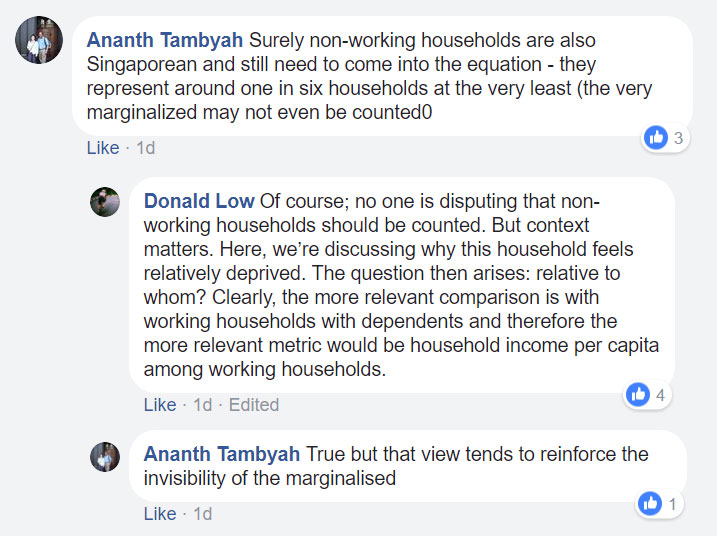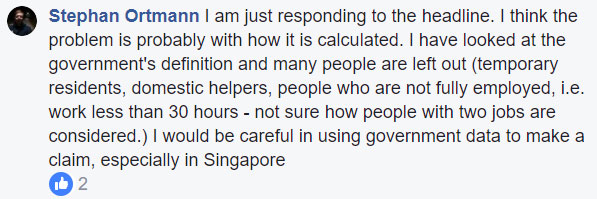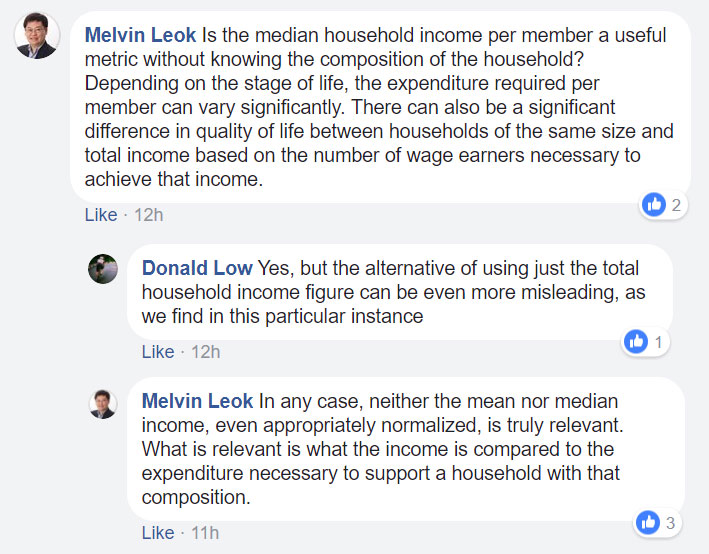Public intellectual and economist Donald Low wrote on Facebook on Feb. 16 that the five-figure income family hung out to dry by the media might really be average, according to Singapore’s standard of living today.
This prompted a heated discussion via comments on Facebook on how the average and median income numbers were derived and how should these numbers be applied and rationalised.
The following information has been collated based on these discussions.
Department of Statistics
The figures that Low relied on and cited are from the Department of Statistics Singapore:
The official stats disclosed include both the average and median figures, which partially lays to rest any accusations of cherry-picking data, as both average and median figures have been used.
What is average vs median Singapore household income?
In 2017, the average household income from work was S$12,027.
The median income from work was S$9,023.
The 2017 figure was higher than 2016.
In 2016, the average household income from work was S$11,589.
The median income from work was S$8,846.
Per member?
According to per capita (or per member) calculations, once again, the 2017 figure was higher than 2016.
In 2017, the average household income per member was about S$3,800, the median S$2,700.
In 2016, the average household income per member was about S$3,600, the median S$2,600.
[related_story]
In other words...
Using the latest rounded off 2017 figures derived from the Department of Statistics:
Average household income in Singapore among working households: S$12,000
Median household income in Singapore among working households: S$9,000
Average household income per member: S$3,800
Median household income per member: S$2,700
Assumptions about five-figure income family with five members
This is where assumptions come in.
1) Assuming the family of five makes S$11,000
In per member terms, its income per member of S$2,200 is below both the average and median in 2017.
This family can be said to earn an income as a whole that would be considered quite average: Above the median, and below the average household income.
2) Assuming the family of five makes S$12,000
In per member terms, its income per member of S$2,400 is below both the average and median in 2017.
This family can be said to earn an income as a whole that would still be considered quite average: Above the median, but just qualifies as the average household income.
3) Assuming the family of five makes S$13,000
In per member terms, its income per member of S$2,600 is still below both the average and median in 2017.
This family can be said to earn an income as a whole that would still be considered average: Above the median, and above the average household income, but lower than the average and median household income per member.
Implications
In a second Facebook post on Feb. 17, one day after the first post came out, Low elaborated more on the implications of the data: Namely, the five-figure income family is not exactly well-off, going by the official statistics.
He said he updated his original post to include updated 2017 figures instead of 2016's, which shows he is not fudging numbers, as it still resulted in his conclusions being the same as before.
So, here's something both the wonks and randos can take away from this discussion:
A rising average income reflects the productivity gains due to the technical advances (in a way that a stagnant median does not), while the growing gap between the average and the median reflects growing inequality.
This is so as top income earners raises the average but not the median. (See below: When is an average measure more meaningful?)
Existing areas of dispute
As thorough as the data appears, the premise of the calculations hinges on what the five-figure income really is.
A five-figure income can be assumed to be anywhere above S$10,000 and below S$99,999. Knowing the exact figure (say, S$35,000), would alter the rationalisations and calculations differently.
Other considerations introduces additional dimensions to the argument.
For example, even though it has been noted that this five-figure income family earns more than 64 percent of households in Singapore, this 64 percent figure includes 12 percent of non-working households presumably made up of retiree households that don't have young dependents.
If this 12 percent is removed to focus on working households, the five-figure income family would be even closer to the average.
But this brings about another set of issues.
For example, how justifiable is it to remove an entire class of households from the data just because they are considered non-working households?

And then there are also objections to relying solely on government data.

The fidelity of the data to reality is one thing, the other issue is that reams and reams of data might have been collated in a way that makes drawing of precise conclusions impossible.
And then there are others who argue that it is impossible to generalise at all, because different families are different in different ways:

Consider a society of 10 people, where the first guy earns $1,000, the second $2,000, the third $3,000 and so on, until the 10th guy who earns $10,000.
In this society where there is no skew in the income distribution, the median and the mean are the same ($5,500) and it doesn’t matter which measure we use.
Now, consider another society where the first six people earn between $1,000 and $6,000 (as in the first society), but the seventh guy earns $12,000, the eighth $13,000, the ninth $14,000 and the tenth $15,000.
In this society, the median is still $5,500 but the mean (or the average) is considerably higher ($7,500).
Now, put yourself in the shoes of the sixth guy earning $6,000. It would be cold comfort to know that you make more than the median.
For you, the average measure better reflects your sense of relative deprivation, and the kind of society you live in.
In an unequal and highly competitive society, it is possible that many middle income households feel this way.
They are not deprived in an absolute sense, but they feel stretched.
For the five-figure income family, the income per member is not just lower than the average, it is also lower than the median.
If you like what you read, follow us on Facebook, Instagram, Twitter and Telegram to get the latest updates.
